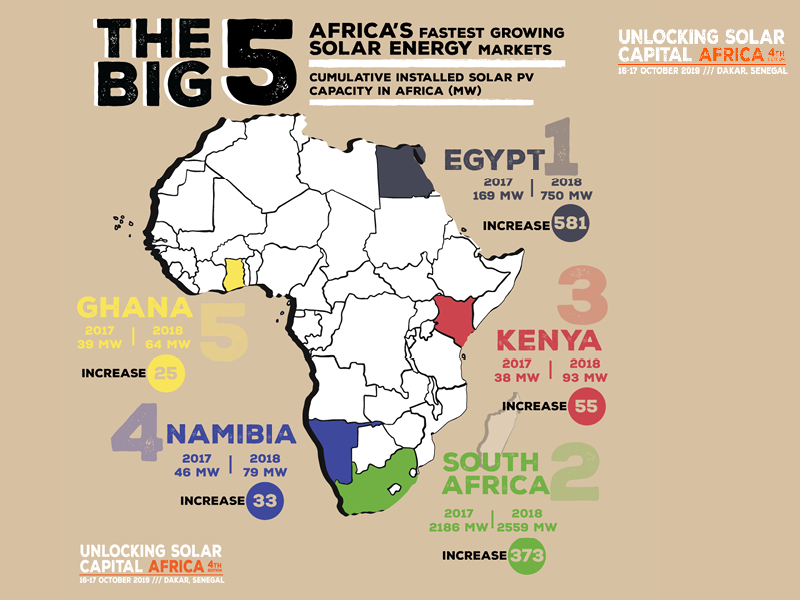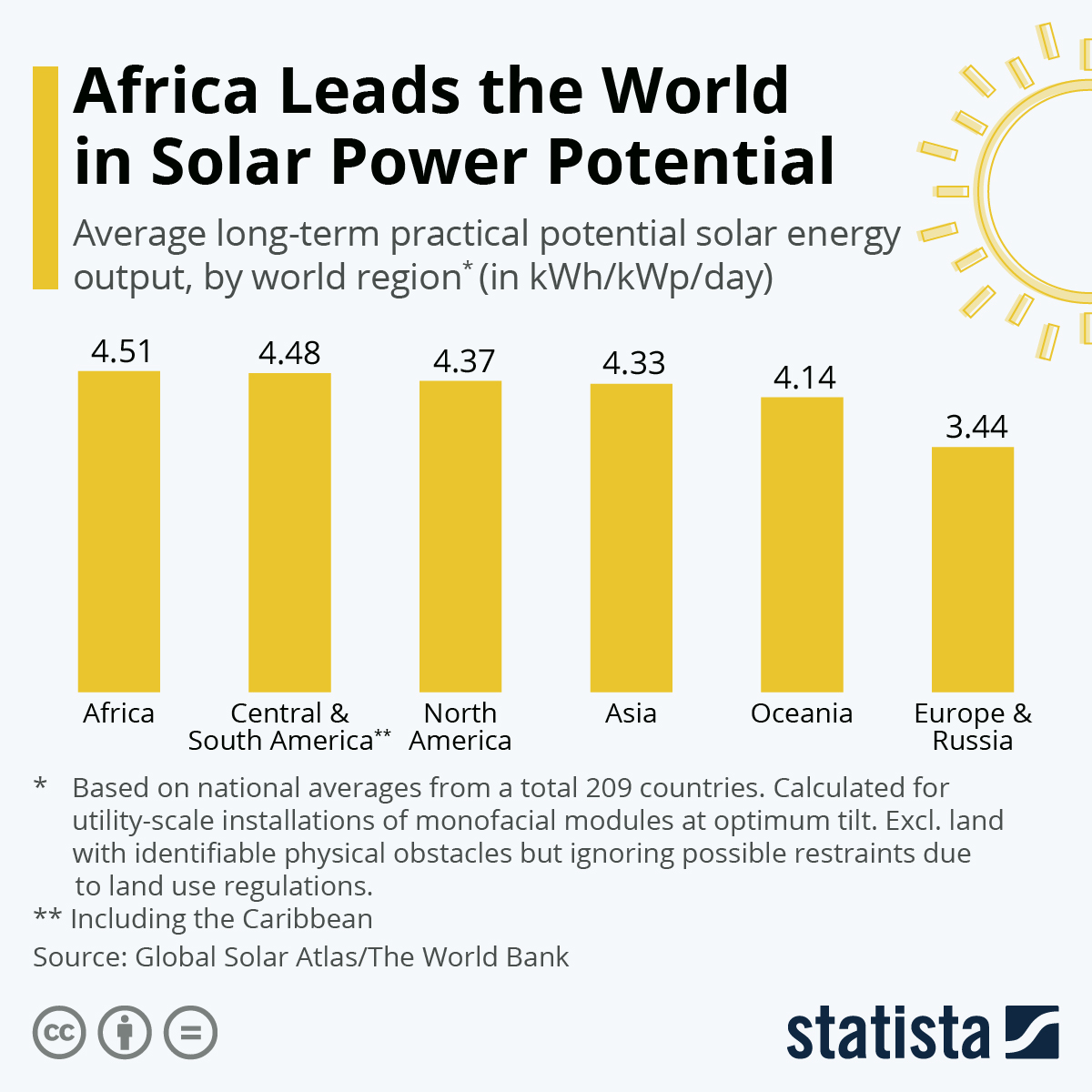
In 2018, five countries in Africa collectively contributed 1,067 MW of new PV capacity. To dissect this development, Solarplaza analyzed the 5 fastest growing solar PV markets in Africa in more detail based on 2018 statistics provided by the International Renewable Energy Agency (IRENA).
Egypt – one of the sunniest countries in Africa – had a good year for new PV installations, making it Africa’s fastest growing solar market in 2018, ahead of South Africa, Kenya, Namibia and Ghana. Last year, the country’s solar industry popped up, adding about 581 MW of new PV capacity, a nearly four-fold increase from 2017’s installations, and thus outpacing South Africa’s 373 MW of new PV capacity. Much of this capacity is concentrated in the huge Benban Solar PV complex, which is still adding MW of capacity every day.
South Africa has long been hailed as Africa’s largest solar market, and it makes sense. With 2.5GW of installed PV capacity, the country is by far the largest market for operational solar systems. However, the country’s solar market has experienced some stagnation over the past few years, especially due to the postponement of its renewable energy auctions. Still, South Africa was able to add 373MW of solar capacity to its power mix in 2018.
Kenya, one of the strongest and most advanced economies in Central and East Africa, added 55 MW of new PV capacity, a new record for the country. The country’s current energy mix consists of around 65 percent renewable energy, making it one of Africa’s leaders in renewable energy. However, the solar industry still has a lot of work to do if it wants to challenge hydropower in the renewable energy space.
Namibia, the driest country in sub-Saharan Africa, nearly doubled its installed PV capacity from 46 MW in 2017 to 79 MW in 2018. The country has always shown great potential for solar development, but has only recently been able to really make strides up to the plate.
Ghana, the only West African country highlighted in this report, has seen an impressive amount of attention to solar development over the past few years. The country added 25 MW of new PV installations in 2018, bringing the cumulative installed solar capacity to 64 MW, an annual growth rate of 76%.

The future looks bright for Africa’s solar energy. The African region is rich in solar energy resources. Three-quarters of the land can receive vertical sunlight. The availability of solar power generation is high and the potential is huge.
It is understood that the current level of electricity development in Africa is relatively low. According to data, the per capita electricity consumption is only 200 kWh, and in many countries it is even lower than 100 kWh. About 600 million people are still without electricity. Large-scale photovoltaic ground-based power stations can supplement the insufficient power supply of the local power grid, and photovoltaic off-grid systems can break the shackles of no power facilities and support local basic living electricity.
“The African” once published an article that Kenya, Tanzania and Ethiopia jointly account for more than 60% of the off-grid photovoltaic market share in sub-Saharan Africa. Among them, more than 30% of Kenya’s population use off-grid photovoltaic products.
Africa is becoming the most important solar energy development region in the world. According to the “Africa Renewable Energy Plan”, 300 billion kWh of installed renewable energy capacity will be built by 2030, meeting half of the energy needs of the African continent; by 2050, Africa’s clean energy will account for 16% of the world’s total clean energy. According to a relevant report from the International Renewable Energy Agency (IRENA), the cumulative installed capacity of photovoltaics in Africa will exceed 70 GW by 2030.
In recent years, the global photovoltaic market has become significantly decentralised, the concentration of China’s photovoltaic product export market has continued to decrease, and the situation dominated by emerging markets has continued to expand. Africa has also become an important market for China’s photovoltaic “going out”. For example, China’s JinkoSolar provided 1 MW of high-efficiency modules for the Manono project, Africa’s largest off-grid photovoltaic power plant. During the Beijing Summit of the Forum on China-Africa Cooperation in 2018, China and Africa also signed a number of clean energy cooperation agreements including photovoltaics.
In fact, the development of renewable energy is becoming a trend in Africa. The photovoltaic market is most promising in northern Africa and southern Africa. Many countries have introduced relevant policies to encourage the development of clean energy. For example, Egypt and Kenya focus on the development of new energy industries and encourage investment in public-private partnership; Morocco plans to increase the proportion of renewable energy to 42% of the total installed power by 2020, and encourage foreign companies to invest in photovoltaic and wind energy; the Nigerian government is currently committed to In promoting the privatization reform of electric power enterprises, it is very attractive in terms of investment preferential policies.
Wajir, chairman of the Federation of African Chambers of Commerce and Industry, said that at present, free trade zones have been established in northern, southern, eastern and western Africa, adopting a manufacturing subcontracting system and enjoying 35%-55% tax reduction. “Africa has made positive progress in terms of legislation and reforms,” Wajir said. “Africa is now a continent of opportunity.”
In addition, financing is also the focus of the African photovoltaic industry. According to Mohamed Etre, President of the Bank of Egypt, during the Beijing Summit of the Forum on China-Africa Cooperation in 2018, the Bank of Egypt joined the China-Africa Union Association and will carry out more cooperation in the future.
A look around South Africa and one can see the plight of many who are without lights or electricity on a daily basis. In some settlements, residents are having to steal power from electricity towers resulting in dangerous methods that can put their lives at risk. Thankfully we are moving towards better times and South Africans as a whole are looking towards alternative renewable power sources. With the rising day to day costs of living as well as the restriction of electricity, it is no wonder that homeowners are looking for an alternative source of energy. South African weather is particularly great as the country experiences at least 8 to 12 hours of sunlight depending on the season and province. This means that sun exposure can be put to good use and supply households with energy that is efficient and can help in these tough economic times.
Solar fans and rechargeable fans are a good fit in hot African weather.

